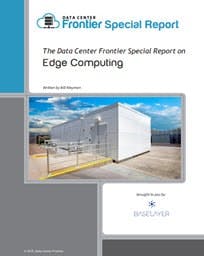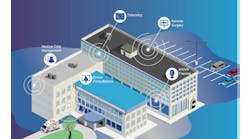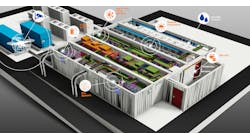AUSTIN, Texas – Edge computing is a hot trend. Are there opportunities for individual investors to capitalize on the future growth of distributed computing?
Not yet, according to several panels at the Edge Congress that explored the investment climate for edge computing, who say it may be several years before there is a “pure play” opportunity to invest in companies targeting this niche.
“We’re in the early innings,” said Phil Kelley, the Senior VP of Corporate Development and Strategy at Crown Castle. “We may still be singing the national anthem.”
There is a group of startups developing hardware and software to support the deployment of IT infrastructure at the edge of the Internet and mobile networks, which is seen as a key step in supporting the growth of emerging technologies like the Internet of Things, AI, augmented reality and autonomous vehicles.
These startups have been funded primarily by private equity firms, angel investors and founders. Some are also being backed by corporate partners like Crown Castle, the largest operator of cell sites in the U.S., which is an investor in edge computing specialist Vapor IO.
Although it may be early in the game for individual investors, private money is paying close attention, with some placing early bets while others wait for clarity on which strategies may prevail.
An Extension of Data Center Growth
Edge computing is a technology that combines data center infrastructure, mobile networks and real estate. Thus far, the best available way to invest in edge has been through shares of companies positioned to benefit from broad adoption of edge, such as real estate investment trusts (REITs) specializing in telecom towers and wireless antennas.
The data center sector has drawn intense attention from investors in recent years. That includes public investors buying shares of real estate investment trusts (REITs) specializing in data center development, as well as professional investors seeking to acquire companies and fund projects.
Edge Computing 101: A Guide to the Emerging Players
“A huge amount of investor money wants to be in the space,” said Christof Hammerli, who invests in digital infrastructure for Landmark Dividend, who said that the specialized nature of data centers often involves a learning curve for investors. That’s especially true for edge computing.
“Everyone’s definition of the edge is different,” said Jeff Ferry, a Director at Goldman Sachs who focuses on the data center sector “There’s different facets of where you invest in this.
“There’s no identifiable business case yet,” Ferry added. “None of these companies have revenue that is investable.”
The development of the business model is key in defining the opportunities, according to Jonathan Atkin, Managing Director at RBC Capital Markets, who said investors are watching the space and becoming aware of some of the privately-funded startups.
“A lot of seeds are going to be planted,” said Atkin. “The business case has to be there. Who pays what to whom in these edge data centers? That has to be sorted out.”
A Look at the Emerging Players
The emerging players in edge computing include startups and new business infrastructure initiatives from existing players. They include:
- Vapor IO offers software and hardware for edge installations, and plans a national network of colocation space in data center modules, located either at the base of towers or urban rooftops. Its leadership includes Cole Crawford, former executive director of the Open Compute Project, and Goldman Sachs veteran Don Duet. The company’s investors include private equity firm Berkshire Partners and Crown Castle.
- EdgeMicro also plans a network of colo sites in data modules, and is founded by executives with experience at Schneider Electric, CyrusOne and 5NINEs. The company recently raised a $3 million round of seed funding.
- DartPoints is developing edge computing solutions for cell tower sites, universities and business campuses. The company is the early mover in the space, and began planning a distributed network of micro data centers in 2012. Its target market also includes carriers that will need to rapidly expand their wireless infrastructure to support 5G broadband services.
- Compass EdgePoint is the edge computing business of Compass Datacenters, formed through the acquisition of BitBox USA and EdgePoint Systems. The company is providing micro modules to support EdgeMicro’s expansion, illustrating the “co-opetition” likely to characterize the edge ecosystem.
- Edge startup Packet focuses on bare metal server infrastructure, and has a handful of deployments in the works at tower sites. Packet’s leadership team includes veterans of Internap, SoftLayer and Equinix. The company recently raised a $25 million Series B round, and investors include Third Point Ventures, Battery Ventures, Samsung NEXT, SoftBank Corp. and Dell Technologies Capital.
- DCBlox builds regional data centers in underserved markets using a modular design and lean construction methods, employing precast components. The company has raised more than $53 million from equity investors and the DC BLOX management team, along with debt financing from Metropolitan Partners Group.
- DataBank and Vertical Bridge are partnering to build a network of micro data centers at the base of cell towers to support demand for edge computing.
- EdgeWorx emerged from stealth today offering edge software solutions, with seed funding from Samsung NEXT, Sequoia Seed and CloudScale Capital Partners.
- Startups offering edge analytics include Swim.ai and Foghorn Systems, among others. Swim recently raised a $10 million Series B round from Cambridge Innovation Capital, Silver Creek Ventures and Harris Barton Asset Management. Foghorn has raised $47 million in multiple rounds of financing, with investors including Intel Capital, Saudi Aramco, GE and Dell Technologies Capital.
- Among public companies, edge could boost business for tower REITs, including Crown Castle, American Tower and SBA Communications.
- Data center equipment vendors are also seeking a piece of the edge computing action, including Vertiv, Schneider Electric, Eaton and Stulz.
The first revenue stream is likely to be driven by 5G wireless, as the major mobile operators (AT&T, Verizon, T-Mobile and Sprint) seek to build out their next-generation tower and cell networks.
Download the Data Center Frontier Special Report on Edge Computing
“We think the edge will be important for 5G,” said Crown Castle’s Kelley. “If you want to put something near the edge of the network, our real estate is as close as you can get.”
Edge computing deployments are expected to accelerate from 2019 through 2021, as the mobile operators’ 5G strategies take shape and they begin to deploy infrastructure in earnest.
Seeking Trends Beyond 5G
In the meantime, existing players are watching the edge sector to understand the opportunities for expansion or acquisition. That includes the data center and tower REITs, according to RBC’s Atkin.
“The public guys are getting involved through minority investments and joint ventures,” said Atkin, noting Crown Castle’s stake in Vapor IO and Digital Realty’s investment in Megaport, which provides software-defined networking (SDN) to boost connectivity to clouds (and eventually edge ecosystems).
Clearing the Confusion: Defining the Layers of Edge Computing
Regional data center operators are among the most interested parties, and most see edge infrastructure extending to second-tier cities before rural telecom sites.
“Ultimately, the network is not out at the cell tower,” said Raul Martynek, CEO at DataBank, a regional colocation player backed by Digital Bridge. “There are interim points between Ashburn and the cell tower, and history tells us those interim points will happen first.”
“From an edge perspective, we will see new markets where there will be capital deployed,” said Patrick Fiel, head of corporate development at EdgeConneX, which operates 25 regional sites in second-tier U.S. markets. “We’re still trying to figure out where we’re going to play.”
“The edge doesn’t have a software model,” said Jason Carolan, Chief Cloud Officer at Flexential, a regional colocation provider. “Until that gets figured out, it will be slow going. If you’re not a 5G deployment for one of the telecoms, you don’t really have an operating model right now.”
Investors may be waiting for the winning models to emerge, but they are convinced that they will.
“4G is what made all of today’s apps happen,” said Hammerli of Landmark Infrastructure. “All of this (wireless infrastructure) needs to become one network and work as a utility. We’re not there yet with mobile data. Once that gets fixed, we’ll get the apps that we don’t even know we need yet.”
Explore the evolving world of edge computing further through Data Center Frontier’s special report series and ongoing coverage.







